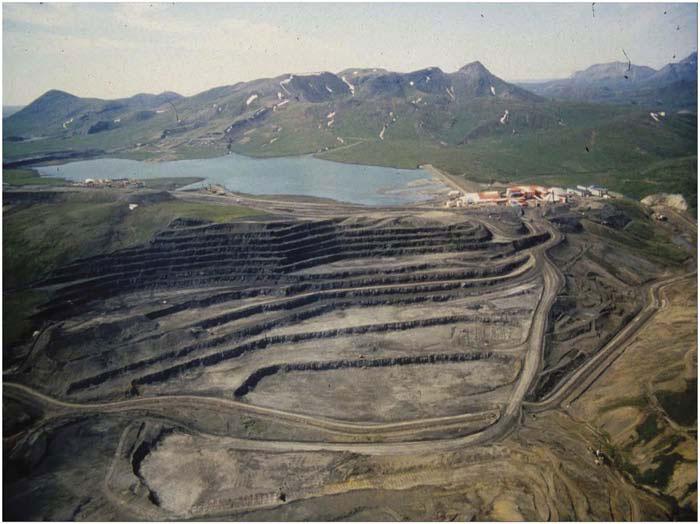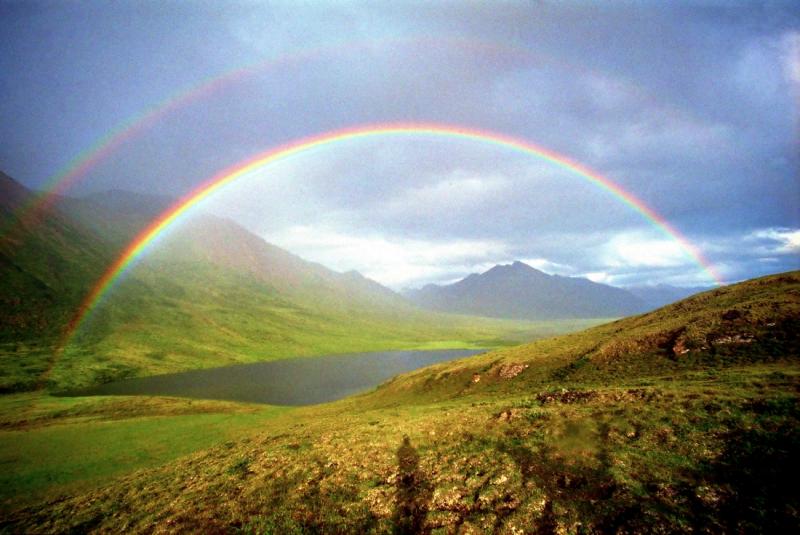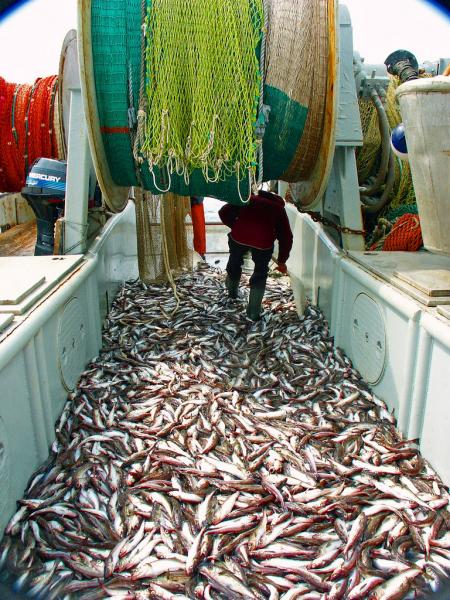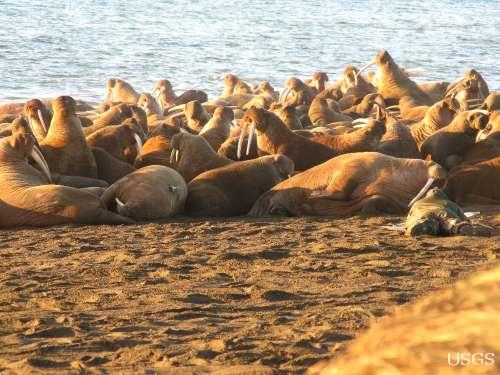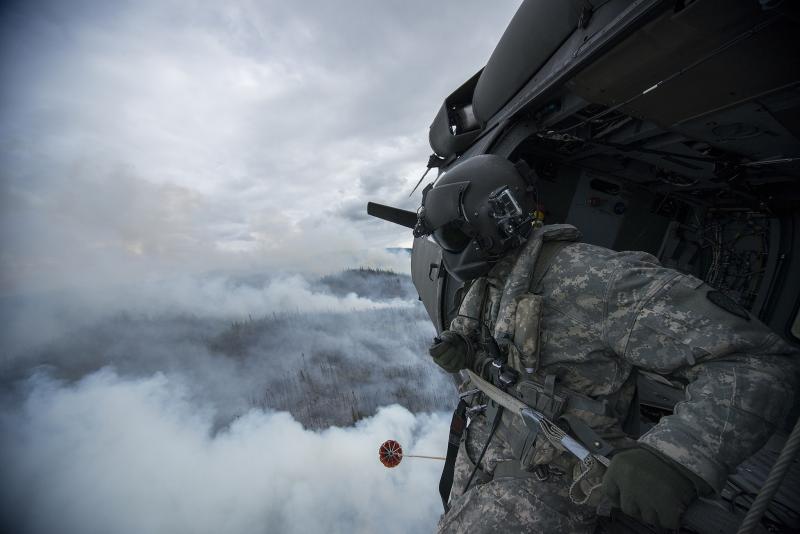Arctic Peoples and Ecosystems
“My dad, he’s a naturalist because he’s an indigenous person. He’s his own biologist, anthropologist, he’s a scientist. He’s got his own Yup’ik degree. He tells my nephews, don’t go out tomorrow, stay home and chop wood because he can look at the weather and next day is a blizzard. He looks every year, I go out with him every year berry picking. He loves nature, that’s where we get our love of nature.”
—Margorie Hastings, Bristol Bay region, New Stuyahok Traditional Council
Changes in the land and sea environments impact the economy, health and quality of life, and the ecosystems that many people—especially Native Peoples—depend on economically, nutritionally, and culturally for hunting and fishing. Climate impacts on these communities are magnified by additional social and economic stresses. However, Native communities have for centuries adapted to changing environmental conditions and have deep cultural values that enhance flexibility and adaptability. See also the Tribal Nations topic and subtopics.
Economic impacts
Energy production is the main driver of Alaska’s economy, providing more than 80 percent of state government revenue and thousands of jobs. Continuing pressure for oil, gas, and mineral development on land and offshore in ice-covered waters increases the demand for infrastructure, placing additional stresses on ecosystems. Land-based energy exploration will be affected by a shorter season when ice roads are viable, yet reduced sea ice extent may create more opportunity for offshore development. Climate also affects hydropower generation by changing the timing, amount, and/or duration of precipitation (see also Energy Production).
Mining and commercial fishing are the second and third largest industries in the state, with tourism rapidly increasing since the 1990s. Fisheries are vulnerable to changes in fish abundance and distribution that result from both climate change and fishing pressure. Tourism might respond positively to warmer springs and autumns, but negatively to less favorable conditions for winter activities and increased summer smoke from wildfires.
Impacts of reduced sea ice
With reduced sea ice extent, the Arctic Ocean is more accessible for marine traffic, including trans-Arctic shipping, oil and gas exploration, and tourism. These activities increase the risks of industrial or marine accidents, but they can also provide new economic opportunities (see also Arctic Development and Transport).
With the late-summer ice edge located farther north than it used to be, storms produce larger waves and more coastal erosion. An additional contributing factor is that coastal bluffs that were once “cemented” by ice-rich permafrost are beginning to thaw in response to warmer air and ocean waters, and are therefore more vulnerable to erosion. Standard defensive adaptation strategies to protect coastal communities from erosion—use of rock walls, sandbags, and riprap (rock or other material used to armor shorelines) and other strategies—have been largely unsuccessful. Several coastal communities are seeking to relocate to escape erosion that threatens infrastructure and services, but because of high costs and policy constraints on use of federal funds for community relocation, only one Alaskan village has begun to relocate.
Health and quality of life
Most rural Alaskan communities are not connected to the state’s road system or electrical grid, so the cost of living is high, and it is challenging to supply food, fuel, materials, health care, and other services. Major food sources are under stress due to many factors, including lack of sea ice for marine mammals. Thawing of near-surface permafrost beneath lakes and ponds that provide drinking water cause food and water security challenges for villages. Sanitation and health problems also result from deteriorating water and sewage systems, and ice cellars traditionally used for storing food are thawing.
Such changes may be particularly threatening to Alaska Native communities, whose subsistence lifestyle is part of an enduring cultural tradition spanning centuries. See the Tribal Nations topic of this Toolkit to learn how climate disproportionately affects indigenous peoples in the United States, and about their unique ways of blending Traditional Knowledges with climate science and technology.
Changes in the timing and quality of ice make traveling conditions for hunters, fisherman, and those going between communities more unpredictable and sometimes dangerous. There are an increasing number of reports of people going through thin ice, often in remote locations where immediate response and rescue is difficult, if not impossible.
“Seasons are really different now. I grew up traveling and could pretty much predict what weather was going to be, and really can’t do that anymore. Listening to weather forecast, gets very dangerous for our people harvesting. Listening to forecast and observing ice conditions, didn’t have to worry. But ice conditions are thinner now and create problems for our harvesters. Our seasons are really changing.”
—Frank Pokiak, Invialuit Game Council
Warming also releases pollutants, such as poleward-transported mercury and organic pesticides, from thawing permafrost. Diseases may also spread into new regions as the climate changes. Both pollutants and diseases may cause harm to Arctic plants and animals—including subsistence food species—posing new health challenges, especially to rural communities. Positive health effects of warming include a longer growing season for gardening and agriculture.
Connections to ecosystems
Functioning ecosystems serve as a foundation for human well-being by providing basic necessities such as food and water and other ecosystem services. Moreover, for indigenous peoples and many rural communities, culture is constructed around livelihood activities, such as reindeer husbandry, farming, fishing, and hunting and gathering. Changes in the environment can thus lead to the erosion or loss of core elements of culture.
Northern communities in Canada have long considered the land and resources around them as crucial to their well-being. Many Inuit, Athabaskan, Métis, and other northern peoples recognize the importance of respectful symbiotic relationships between themselves and the water, fish, wildlife, and other beings of their natural world. What’s more, these relationships are imbued with sacred or spiritual significance. Beliefs that people and animals “are related like families,” and that the “land is alive” and can be managed by people only when treated with respect, are described in oral histories documented throughout the North, particularly in First Nations communities. In this context, the experience of environmental change is deeply personal and spiritual and can really only be understood through lived experience and the development of long-term, respectful social and social-ecological relations. The people of Alaska, along with other Arctic residents in other nations, rely on and have strong connections to marine and terrestrial ecosystems, both of which are experiencing climate change.
Rapid erosion and storm vulnerability due to sea ice loss have forced tribes to prepare to leave their homes and lands. Thirty-one villages are identified as being in imminent danger. At least 12 of the 31 threatened villages have decided to relocate or to explore relocation options.1 Federal funds are scarce, competition is steep, and, due to complex eligibility criteria, many Alaska tribes cannot qualify for needed federal programs.
Marine and coastal ecosystems
Ocean acidification, rising ocean temperatures, declining sea ice, and other environmental changes interact to affect the location and abundance of marine fish, including those that are commercially important, those used as food by other species, and those used for subsistence. These changes have allowed some near-surface fish species such as salmon to expand their ranges northward along the Alaskan coast. In addition, non-native species are invading Alaskan waters more rapidly, primarily through ships releasing ballast waters and bringing southerly species to Alaska. These species introductions could affect marine ecosystems, including the feeding relationships of fish important to commercial and subsistence fisheries.
Overall habitat extent is expected to change as well, though the degree of the range migration will depend upon the life history of particular species. For example, reductions in seasonal sea ice cover and higher surface temperatures may open up new habitat in polar regions for some important fish species, such as cod, herring, and pollock. However, continued presence of cold bottom-water temperatures on the Alaskan continental shelf could limit northward migration into the northern Bering Sea and Chukchi Sea off northwestern Alaska. In addition, warming may cause reductions in the abundance of some species, such as pollock, in their current ranges in the Bering Sea and reduce the health of juvenile sockeye salmon, potentially resulting in decreased overwinter survival. If ocean warming continues, it is unlikely that current fishing pressure on pollock can be sustained. Higher temperatures are also likely to increase the frequency of early Chinook salmon migrations, making management of the fishery by multiple user groups more challenging.
Ocean acidification
Research is showing that ocean acidification is already affecting northern waters. It is a complex issue and the impacts may vary between Arctic regions, depending on variables such as water temperature, glacial melt and runoff, and ocean circulatory patterns. The impacts on the food chain are not yet fully understood, but already some of the essential plankton and small invertebrates are showing physical changes. Ocean acidification may cause a loss of primary food sources for species that are physically, economically, and culturally essential. The rising acidity will have particularly strong societal effects in the Bering Sea on Alaska’s west coast because of its high-productivity commercial and subsistence fisheries. Shelled pteropods—tiny planktonic snails near the base of the food chain—respond quickly to acidifying conditions and are an especially critical link in high-latitude food webs, as commercially important species such as pink salmon depend heavily on them for food.
Coastal zone habitats
The Arctic coastal zone is the interface between the seas of the Arctic shelf and the Arctic terrestrial regions—the realm where the terrestrial ecosystem is affected by proximity to the marine, and vice versa—and which as a result is sensitive to changes or shifts in either. As a result of this interaction, the coastal zone supports high structural and ecological diversity, which includes its human component.
A reduction in sea ice is altering habitats along Arctic coastlines. Some of the most recognizable Arctic animals, such as polar bears, seals, and walruses, rely on sea ice as a platform for resting and hunting. Like the Arctic’s human residents, these animals face the loss of habitat and drastically reduced hunting ranges as sea ice recedes. Polar bears are one of the most sensitive Arctic marine mammals to climate warming because they spend most of their lives on near-shore sea ice. Declining sea ice in northern Alaska is associated with smaller bears, probably because of less successful hunting of seals, which are themselves ice-dependent and so are projected to decline with diminishing ice and snow cover. Although bears can give birth to cubs on sea ice, increasing numbers of female bears now come ashore in Alaska in the summer and fall and den on land. Walrus also depend on sea ice as a platform for giving birth, nursing, and resting between dives to the seafloor, where they feed. In recent years, when summer sea ice in the Chukchi Sea retreated over waters that were too deep for walrus to feed, large numbers of walrus abandoned the ice and came ashore. The high concentration of animals results in increased competition for food and can lead to stampedes when animals are startled, resulting in trampling of calves.
Terrestrial ecosystems
On land, shrubs are expanding in the tundra and invasive insects are moving into the forests. As Arctic summers warm and the ice-free season lengthens, more species from the south could begin to spread northward. Competition from these species for food and other resources could potentially lead to major ecosystem reorganization and even extinctions. For example, as climate warms, shrubs have started to grow in areas previously dominated by tundra vegetation, such as lichens—an important winter food source for caribou. The loss of lichens can lead to declines in the growth and abundance of caribou, which in turn are an important food source for hunters from the Arctic’s indigenous communities, as well as for predators such as bears and wolves.
Higher temperatures and less summer moisture increase the risks of drought, wildfire, and insect infestation. Alaska's boreal spruce forest declined substantially in recent decades from both fire and insect damage. By mid-century, the average area burned by wildfire each year is likely to double. In the forests, research has shown that increased frequency of wildfires in the conifer forest (for which increasing summer temperature is the main driver) will likely turn the landscape into a deciduous broad-leaf forest, as the dominant slow-growing conifer black spruce (Picea mariana) is replaced by more open ecosystems dominated by aspen and birch.
On average, lakes have decreased in area in the last 50 years in the southern two-thirds of Alaska, due to a combination of permafrost thaw, greater evaporation in a warmer climate, and increased soil organic accumulation during a longer season for plant growth. In some places, however, lakes are getting larger because of lateral permafrost degradation. Future permafrost thaw will likely increase lake area in areas of continuous permafrost, and decrease lake area in places where the permafrost zone is more fragmented. Many communities in northern Alaska draw their drinking water from lakes and other surface waters. Changes in water availability may require new water sources and new treatment technologies.
A continuation of the current drying of Alaskan lakes and wetlands could affect waterfowl management nationally: Alaska accounts for 81 percent of the National Wildlife Refuge System and provides breeding habitat for millions of migratory birds that winter in more southerly regions of North America and on other continents. Wetland loss would also reduce waterfowl harvest in Alaska, where it is an important food source for Alaska Natives and other rural residents.
The preceding text is excerpted and abridged from the following sources:
- Climate Change Impacts in the United States: The Third National Climate Assessment (Chapter 22: Alaska).
- Arctic Resilience Interim Report 2013.
- Alaska Native Villages: Limited Progress Has Been Made on Relocation Villages Threatened by Flooding and Erosion.
- Arctic Matters: The Global Connection to Changes in the Arctic.
- U.S. Environmental Protection Agency, 2015: Climate Impacts in Alaska. Accessed September 2016.
- 1U.S. Government Accountability Office (2009): Alaska Native Villages: Limited Progress Has Been Made on Relocation Villages Threatened by Flooding and Erosion. GAO-09-551, 48 pp.

